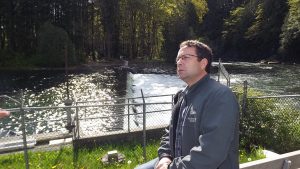Fisheries and Oceans Canada, in conjunction with BC Hydro, is revising a summer chinook strategy in an effort to increase the number of fish in the Puntledge River.
With the water level dropped Thursday, staff could conduct snorkel surveys to determine if any adult fish had swan upstream or were holding below the weir.
Monitors watched for leaping fish during the surveys.
“We’ve been down to low numbers of fish, approaching 100 adults,” said Darcy Miller, watershed enhancement manager at the Puntledge River Hatchery.
Over time, various strategies have improved the situation. In recent years the river has averaged about 1,100 adult chinooks per year. The goal is to reach 2,500 to 3,500 fish.
“The Puntledge River has a unique stock of summer chinook, and those enter the system between May and August,” Miller said. “There’s only two runs of summer chinook on Vancouver Island, that’s here and Nanaimo.”

DARCY MILLER PONDERS the future of fish in the Puntledge as he stands near the fish weir at the river’s lower hatchery. Photo by Scott Stanfield
As chinook start entering the Puntledge to prepare to spawn, BC Hydro needs to deal with fresh outflows, snow melt and inflows. When water volumes are high, adult chinook can get above the hatchery which makes capture difficult.
Water temperature can also be problematic when it exceeds 20 C in the summer — good for tubers but lethal for salmon. Three years ago, the river reached a high of 26 degrees.
“We lose fish migrating upstream, we also lose fish in holding,” said Miller, noting the Puntledge hatchery has another site about 6.5 kilometres upstream.
A change in strategy is to capture as many chinook as possible locally then transport the fish to cooler waters at hatcheries at Rosewall Creek or Big Qualicum River.
“That gives us a great boost in survival and opportunity to get our egg target,” Miller said, noting the difficulty of attaining the summer chinook target of 1.25 million eggs.
BC Hydro will conduct river test flows from 60, 70 and 80 cubic metres per second in May and June, subject to water conditions, to determine the flow threshold where summer Chinook can leap above the weir.
“It’s very important information to glean,” said Hydro communications officer Stephen Watson, who notes high river flows this year due to the snowpack.
BC Hydro is shifting its two-day fish migration flows normally conducted over five weeks in July and August to June and early-July.
The water level was to be dropped Thursday to about 40 m3/s.
reporter@comoxvalleyrecord.com

